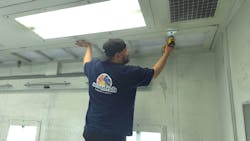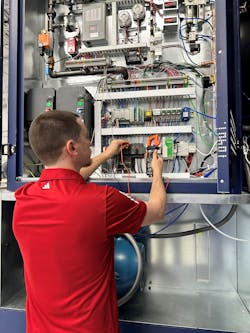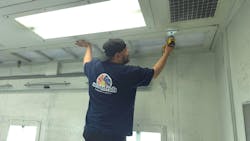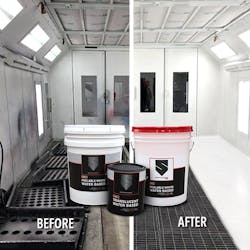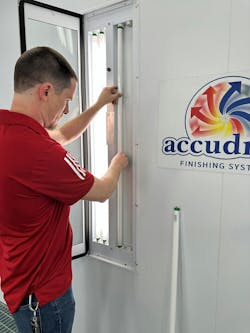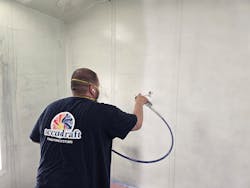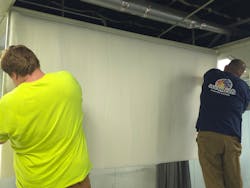Key Highlights
- Regular inspection and timely filter changes are crucial for extending the lifespan of spray booths and preventing costly repairs.
- Signs like recurring electrical failures and outdated heating systems indicate it may be time to upgrade to a more efficient booth.
- Using high-grade filters and protective coatings can reduce maintenance frequency and improve overall booth performance.
- Scheduling planned downtime for maintenance helps avoid unexpected disruptions and keeps operations running smoothly.
- Upgrading to modern booths with direct heating and better design can lead to significant energy savings and increased productivity.
Jeremy Winters remembers the photo — his first appearance in FenderBender, more than nine years ago, back in his days as a painter.
“Pull it up,” says Winters, now a content creator for Accudraft. “You’ll see a picture of me standing in front of a car, pulling the trigger. It's a cool backlit shot. But look at the ceiling filters behind me. The ceiling filters are dark brown, and those things were way overdue.”
Within six months working in that exact same booth, Winters recalls, he felt the concrete vibrate. It turned out that years of overspray had collected on a fan blade, throwing it out of balance and eventually breaking it. The brown filters could’ve been a clue that an inspection was needed, but instead what followed was new fans, a whole new support structure, and a costly repair.
“It was just one of those things of, ‘Yeah, well, it’s not having any problems right now,’ but that’s something that could be checked and seen just during a regular inspection of the booth.”
A pound of prevention
If you’ve found yourself wondering if it’s time to upgrade your spray booth, then consider yourself lucky. That means you haven’t been forced into it due to some catastrophic failure. Lack of inspections and proper maintenance can doom a spray booth which should last easily 20 years — Winters shares there are Accudraft booth that were installed in the ‘80s but are still going strong.
Business needs sometimes dictate upgrading to a new booth, but if it’s just increased performance and efficiency you’re after, first make sure that you’re optimizing the lifespan of your current booth. Winters preaches the importance of changing filters and keeping a log of when they were changed and at what hour reading for the booth, something that you can monitor through Accudraft Live on Accudraft machines for real-time performance diagnostics.
According to Global Finishing Solutions (GFS), filters should be changed every 100 operating hours, or roughly every three to four weeks. But with so much variance in paint operations, some need changing more quickly. And not all filters are created equal either. High-grade filters will be more efficient and require less frequent changes.
“While you may be saving money now, the cheaper quality of the materials will load with paint more quickly,” says David Smith, service and preventative maintenance manager for GFS. “This will cause more frequent filter change-outs. Low-cost alternatives also have a lower capture efficiency. That can lead to an even higher expense of replacing other parts, such as fans, motors and ductwork.”
Other maintenance tips from GFS include using protective booth coatings and floor protection to help reduce overspray. Protecting light fixtures, too, can help ensure that vision remains constant. GFS’ Booth Shield product is peelable so that cleanup is easy.
Finally, GFS recommends establishing a regular maintenance schedule, ideally at the interval recommended by your booth’s manufacturer. The action items on this schedule should include both inspection and cleaning procedures, fixing what needs fixing but inspecting every point of wear. Depending on your booth’s usage, some of these items may need daily inspections.
“In addition to protecting your employees and facility, routine cleaning and maintenance of your paint booth will ensure it lasts for many years to come,” Smith says. “A small investment in time now can result in long-term savings of costly repairs or even booth replacement.”
Winters notes that oftentimes business can get in the way of doing maintenance or performing inspections. As in the example with the out-of-balance fan, if something isn’t causing a problem right then, it can be easy to assume that everything is in order. “Kristen Felder has a great saying of, ‘We never have time to do it right the first time, but we always seem to have time to do it right the second time,’” Winters says.
That’s why he recommends scheduling your booth downtime. What causes disruptions in a shop are sudden things. Downtime is downtime, but if everyone knows it’s coming, it makes it that much easier to plan for.
Time for something new
So, you’re keeping up on your maintenance, doing regular inspections, but all good things must come to an end. When do you know enough is enough and it’s time for an upgrade?
Winters says that recurring electrical failures, to the point where the booth is shutting down and needs a repair visit every time, are a sign that the air makeup unit (AMU) may need an upgrade. But there is only so much retrofitting that can be done on an old booth. Units from 25, 30 years ago commonly utilize indirect heating, which is inefficient by today’s direct heating standards. Direct heating saves roughly 30% in heating costs over indirect, Winters says. So, you’re not only spending money trying to prop up old technology, it’s costing you money even when working properly.
Efficiency is the icing on the cake when upgrading to a new booth. ARO varies widely between shops, but it’s a fact that a new booth will eventually pay for itself, it’s just a question of time before you see that return on investment. If a new booth could help you get even one more car through a month, you can do the math to see those savings add up.
“Once you start looking at it, a lot of times, a booth will pay for itself within about, 12 to 18 months, once you kind of space it out,” Winters says.
As with any investment in equipment, a new or upgraded booth allows you to do two things: Perform jobs with better quality, and perform more jobs. Efficiency is part of the latter, but booth design is also an opportunity to keep cars moving better. That booth you have may have been perfect for when the shop opened, but could a new placement or a new design save precious time in avoiding bottlenecks?
“Is there anything that you could change to help maybe save 5, 10, minutes here and there?” Winters asks. “Do you have a solid-back booth? Well, if the booth is up against the wall, what if we put a door on the outside of that? We’ll put a roll-up door right there and make the booth a drive through.”
Wasted motion is the biggest killer of anything in the body shop, especially in the paint shop. If you can get things moving smoothly, you're going to avoid more and more bottlenecks. - Jeremy Winters, Accudraft
“… Wasted motion is the biggest killer of anything in the body shop, especially in the paint shop. If you can get things moving smoothly, you're going to avoid more and more bottlenecks.”
These are the things to consider if a new spray booth may be in your near future. Understand first that maintenance is part of due diligence. And if your needs call for something new or upgraded, take the time to consider what products can achieve your goals. It’s an opportunity to get your shop running more efficiently and improve your bottom line.
About the Author
Todd Kortemeier
Todd Kortemeier is former editor of FenderBender magazine and started writing as a contributor in 2024.
